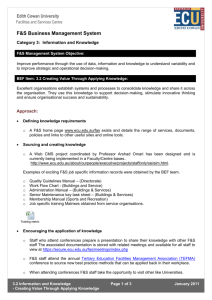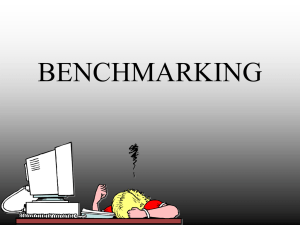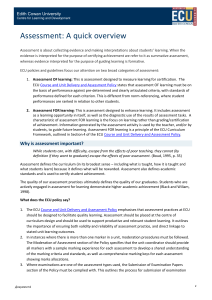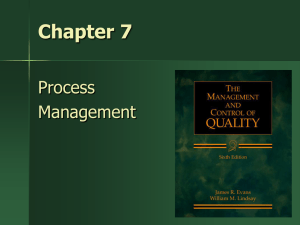Benchmarking learning and teaching: Guidelines
advertisement
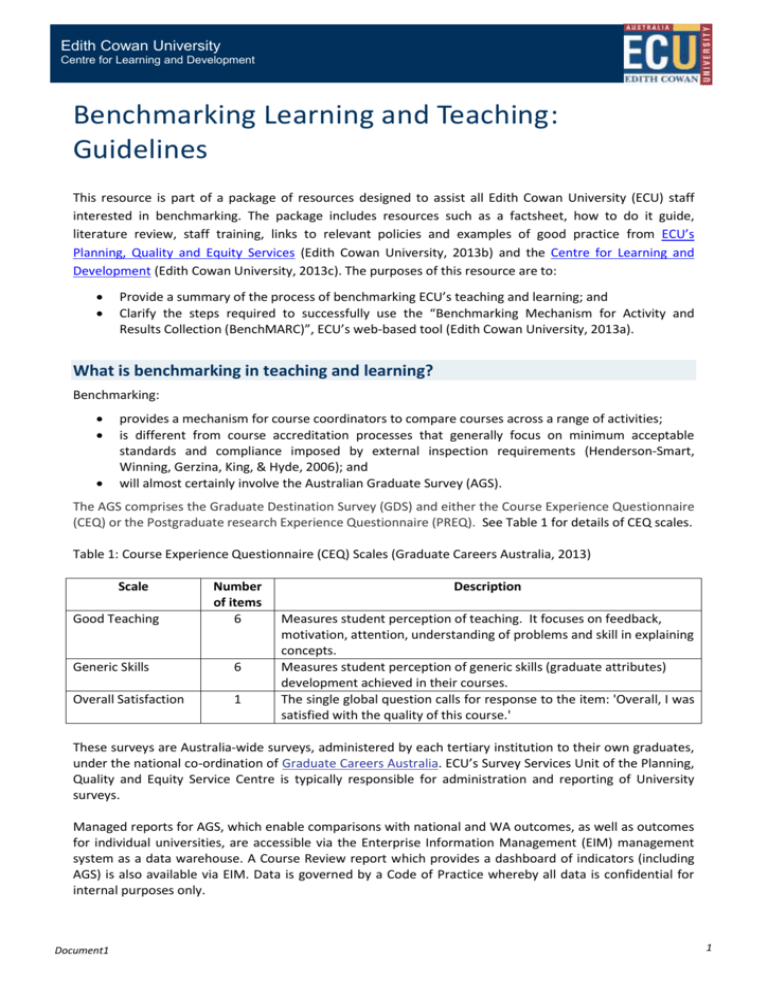
Edith Cowan University Centre for Learning and Development Benchmarking Learning and Teaching: Guidelines This resource is part of a package of resources designed to assist all Edith Cowan University (ECU) staff interested in benchmarking. The package includes resources such as a factsheet, how to do it guide, literature review, staff training, links to relevant policies and examples of good practice from ECU’s Planning, Quality and Equity Services (Edith Cowan University, 2013b) and the Centre for Learning and Development (Edith Cowan University, 2013c). The purposes of this resource are to: Provide a summary of the process of benchmarking ECU’s teaching and learning; and Clarify the steps required to successfully use the “Benchmarking Mechanism for Activity and Results Collection (BenchMARC)”, ECU’s web-based tool (Edith Cowan University, 2013a). What is benchmarking in teaching and learning? Benchmarking: provides a mechanism for course coordinators to compare courses across a range of activities; is different from course accreditation processes that generally focus on minimum acceptable standards and compliance imposed by external inspection requirements (Henderson-Smart, Winning, Gerzina, King, & Hyde, 2006); and will almost certainly involve the Australian Graduate Survey (AGS). The AGS comprises the Graduate Destination Survey (GDS) and either the Course Experience Questionnaire (CEQ) or the Postgraduate research Experience Questionnaire (PREQ). See Table 1 for details of CEQ scales. Table 1: Course Experience Questionnaire (CEQ) Scales (Graduate Careers Australia, 2013) Scale Good Teaching Number of items 6 Generic Skills 6 Overall Satisfaction 1 Description Measures student perception of teaching. It focuses on feedback, motivation, attention, understanding of problems and skill in explaining concepts. Measures student perception of generic skills (graduate attributes) development achieved in their courses. The single global question calls for response to the item: 'Overall, I was satisfied with the quality of this course.' These surveys are Australia-wide surveys, administered by each tertiary institution to their own graduates, under the national co-ordination of Graduate Careers Australia. ECU’s Survey Services Unit of the Planning, Quality and Equity Service Centre is typically responsible for administration and reporting of University surveys. Managed reports for AGS, which enable comparisons with national and WA outcomes, as well as outcomes for individual universities, are accessible via the Enterprise Information Management (EIM) management system as a data warehouse. A Course Review report which provides a dashboard of indicators (including AGS) is also available via EIM. Data is governed by a Code of Practice whereby all data is confidential for internal purposes only. Document1 1 Edith Cowan University Centre for Learning and Development Who is responsible for benchmarking courses at ECU? Usually, the Course Coordinator is the person responsible for planning and conducting the benchmarking activity in conjunction with the Head of School. All benchmarking partners and institutions must be approved by the University or the Head of School before contacting potential partners. The results of benchmarking are used by Heads of Schools in Annual Reviews for Faculty and School Reviews. Reports are automatically generated by the BenchMARC database for this purpose and inserted into the Annual Review template prior to being sent to faculties and centres. Steps for benchmarking a course Before commencing any benchmarking activity, staff should check the policies and resources on benchmarking available from ECU’s Planning, Quality and Equity Services and the Centre for Learning and Development. Benchmarking is part of the group Excellence Framework process (Edith Cowan University, 2013d). A critical component of the ECU Excellence Framework is the Plan/Do/Review/Improve (PDRI) continuous improvement cycle (Edith Cowan University, 2013e). All benchmarking activities at ECU are to use BenchMARC (Benchmarking Mechanism for Activity and Results Collection), an online database application custom-designed for benchmarking at ECU that: provides a consistent approach to benchmarking at ECU; guides staff through the benchmarking process from beginning to end; creates a record of benchmarking activities; and provides a facility for sharing good practice in benchmarking. Before using the system please read the following. The first step is to plan. Step 1: Plan When entering data into BenchMARC, you will be asked a series of questions. If you work your way through the following you will be well prepared. To help answer these questions please see the resources in the links above. For example, you will be specifically asked if you agree with the ECU Code of Conduct. Please note that all benchmarking partners and institutions must be approved by the University or the Head of School before you contact potential partners. Purpose What do you want to achieve from the benchmarking activity? What is the objective/purpose? Does the benchmarking activity align with your Faculty/Centre strategic objectives (in your operational plan)? What type of benchmarking is it? Process Benchmarking; or Outcome Benchmarking. Is there another benchmarking activity being conducted within the University that is similar? Can you speak with the project manager and gain some advantage from their experience? Try to utilise resources that have already been developed. Team Form a benchmarking team (if required) of staff involved in the course and others who may provide “fresh eyes”. See the literature review for some ideas about potential partners (provisional comparators). The likely composition of a course benchmarking team depends on which aspects of the course will be benchmarked. Looking beyond peers to quite different benchmarking partners encourages real innovation. Document1 2 Edith Cowan University Centre for Learning and Development Provisional Comparators What type of benchmarking partner will you choose? The choice of partner is aligned with the aims. What other university is similar to ECU in this discipline? Which other Australian courses are similar to this ECU course? Identify suitable comparators based on characteristics such as: o The leader in the field/market; o Offers a comparable product/service; or o An organisation that is similar in size and complexity. What is the rationale for your selection of benchmarking partner(s)? Does the partnership require the exchange of confidential information? Data Collection What data will be collected? How does this data align with the purpose and aims? How will data be collected? Is there data already freely available? e.g. CEQ A range of survey outcomes are available via managed reports in the EIM data warehouse. You may need to contact your Faculty Business Analyst for help with access to such reports ECU’s Survey Services Unit (in the Planning, Quality and Equity Services Centre) can provide advice on the content and interpretation of such reports, as well as potential limitations. Project Plan What tasks and activities need to be undertaken? What resources will be required (time, money, assistance)? What costs will be incurred? What are the deadlines? Who will take responsibility for tasks/activities? Step 2: Do Final Comparators All benchmarking partners and institutions must be approved by the University or the Head of School before you contact potential partners. Contact your selected comparators and formalise your partnership with a deed of confidentiality if required. See the ECU Benchmarking Code of Conduct (Edith Cowan University, 2012) for a definition of confidential information. Be clear about the information you want from your partner organisation by creating a brief, proforma or template. Data Collection Upload the data that has been collected. Results Sharing Who are you going to share the data with? Step 3: Review Key Findings – What to do to improve the Course Analyse the data/information received or gathered. What are the most important conclusions resulting from the activity? Drill-down further; ask questions of your partner organisation, how did they achieve these results? Did you ask the correct questions, in the correct way? Were you clear about your expectations? Document1 3 Edith Cowan University Centre for Learning and Development Does the data pose new/other questions? How can this course be improved? Who will ensure that these improvements are implemented? How will evidence be gathered to check that changes effect expected improvements? Who will gather this evidence? How will this evidence be reviewed? Self-Assessment and Improvement of Methodology Document the approach you have taken in order to assist you next time you conduct the activity or someone else conducting the same type of benchmarking. Can this be a way to improve the benchmarking instrument for next year? How would you improve the benchmarking methodology next time around? Step 4: Improve Outcomes What were the key outcomes of this benchmarking exercise? Check the purposes and aims. Opportunities for Improvement What were the opportunities for improvement identified as a result of the benchmarking activity? Adaptation of Good Practice Develop ways of improving your process/practice/course based on the information obtained from your partner organisation. Adapt the information to suit your area. Implement the new process/practice/course. Put in place ways to gather evidence that the improvement has an impact on students’ learning. Integrate the improvements into your subsequent operational plan. References Edith Cowan University. (2012). ECU Benchmarking Code of Conduct. from http://intranet.ecu.edu.au/__data/assets/pdf_file/0003/393573/ECU-Benchmarking-Code-of-Conduct.pdf Edith Cowan University. (2013a). BenchMARC. from https://apps.ecu.edu.au/benchmarc/login.php Edith Cowan University. (2013b). Benchmarking. from http://intranet.ecu.edu.au/staff/centres/planningquality-and-equity-services/our-services/benchmarking Edith Cowan University. (2013c). Benchmarking in Higher Education. from http://intranet.ecu.edu.au/learning/for-academic-staff/curriculum-2012-resources/benchmarking Edith Cowan University. (2013d). ECU Excellence Framework policy. http://www.ecu.edu.au/GPPS/policies_db/policies_view.php?rec_id=0000000391 Edith Cowan University. (2013e). Excellence Framework. from http://intranet.ecu.edu.au/staff/centres/planning-quality-and-equity-services/our-services/excellenceframework Graduate Careers Australia. (2013). Course Experience Questionnaire overview. from http://www.graduatecareers.com.au/research/start/agsoverview/ctags/ceqo/ Henderson-Smart, C., Winning, T., Gerzina, T., King, S., & Hyde, S. (2006). Benchmarking Learning and Teaching: Developing a method. Quality Assurance in Education, 14(2), 143-155. doi: 10.1108/09684880610662024 Document1 4

